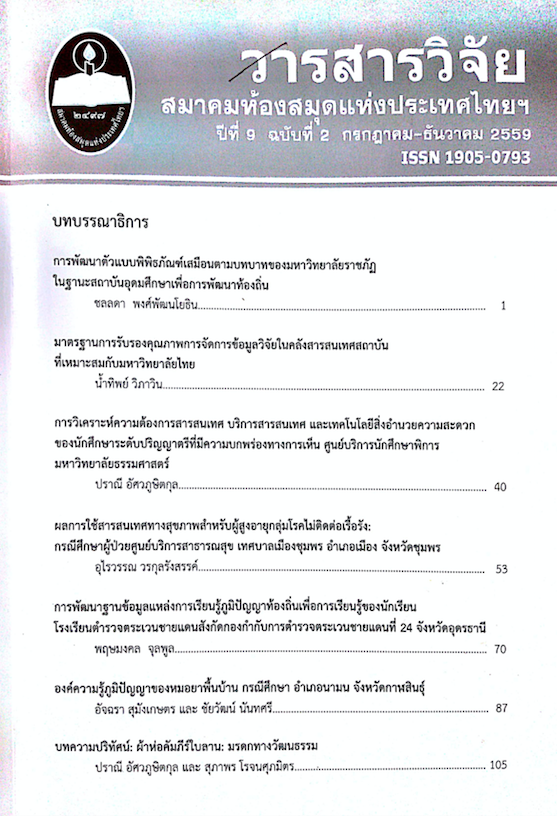ผลการใช้สารสนเทศทางสุขภาพสำหรับผู้สูงอายุกลุ่มโรคไม่ติดต่อเรื้อรัง: กรณีศึกษาผู้ป่วยศูนย์บริการสาธารณสุข เทศบาลเมืองชุมพร อำเภอเมือง จังหวัดชุมพร
Main Article Content
Abstract
การวิจัยนี้มีวัตถุประสงค์เพื่อประเมินระดับความรู้ด้านการดูแลสุขภาพตนเองของผู้สูงอายุกลุ่มโรคไม่ติดต่อเรื้อรัง และศึกษาผลการใช้สารสนเทศทางสุขภาพของผู้สูงอายุกลุ่มโรคไม่ติดต่อเรื้อรัง กลุ่มตัวอย่างที่ใช้ในการศึกษาขั้นตอนที่ 1 : การประเมินความรู้เรื่องโรคและการป้องกันได้แก่ ผู้ป่วยสูงอายุกลุ่มโรคไม่ติดต่อเรื้อรังที่เข้ารับบริการศูนย์บริการสาธารณสุข เทศบาลเมืองชุมพรในระหว่างเดือน กุมภาพันธ์ – มีนาคม 2559 จำนวน 175 คน แบ่งเป็นผู้ป่วยโรคเบาหวาน จำนวน 57 คน ผู้ป่วยโรคความดันโลหิตสูง จำนวน 57 คน และผู้ป่วยโรคหลอดเลือดและหัวใจ จำนวน 61 คน กลุ่มตัวอย่างที่ใช้ในการศึกษาขั้นตอนที่ 2 : การให้ความรู้ด้านสุขภาพ ตามหลัก 3อ 2ส ได้แก่ ผู้ป่วยสูงอายุฯ ซึ่งเป็นผู้ป่วยที่มีระดับความรู้เรื่องโภชนาการ พฤติกรรม และการออกกำลังกายเฉพาะโรคอยู่ในระดับปานกลางหรือต่ำกว่าร้อยละ 50 จากการตรวจประเมินจากแบบสัมภาษณ์ชุดที่ 1 และสมัครใจเข้าร่วมโครงการอบรม จำนวน 84 คน แบ่งเป็นผู้ป่วยโรคเบาหวาน จำนวน 25 คน ผู้ป่วยโรคความดันโลหิตสูง จำนวน 27 คน และผู้ป่วยโรคหลอดเลือดและหัวใจ จำนวน 32 คน เครื่องมือที่ใช้ในการเก็บรวบรวมข้อมูลในการศึกษานี้ ประกอบด้วยแบบสัมภาษณ์อย่างมีโครงสร้าง จำนวน 2 ชุด สถิติที่ใช้ในการวิเคราะห์ข้อมูล ได้แก่ การแจกแจง ค่าร้อยละ และการพรรณนาความ
ผลการวิจัยพบว่า 1) ข้อมูลลักษณะทางประชากรและสังคม ผู้ป่วยทั้ง 3 โรค เป็นเพศหญิงมากกว่าเพศชาย มีอายุระหว่าง 60 – 65 ปี มากที่สุด ส่วนใหญ่จบการศึกษาระดับประถมศึกษาและประกอบอาชีพค้าขายหรือทำงานส่วนตัว ด้านระดับความรู้เรื่องโรคและการป้องกัน ส่วนใหญ่ผู้ป่วยโรคเบาหวาน มีความรู้ที่ถูกต้องด้านโภชนาการที่เกี่ยวข้องกับโรคโดยเฉลี่ยร้อยละ 58.16 ใกล้เคียงกับผู้ป่วยโรคหลอดเลือดและหัวใจที่มีความรู้ที่ถูกต้องด้านโภชนาการที่เกี่ยวข้องกับโรคโดยเฉลี่ยร้อยละ 55.94 ขณะที่ผู้ป่วยโรคความดันโลหิตสูงส่วนใหญ่มีความรู้ที่ถูกต้องด้านโภชนาการที่เกี่ยวข้องกับโรคโดยเฉลี่ยร้อยละ 47.04 2) ด้านพฤติกรรมและการออกกำลังกาย ผู้ป่วยโรคเบาหวานส่วนใหญ่มีความรู้โดยเฉลี่ยร้อยละ 73.68 ใกล้เคียงกับผู้ป่วยโรคความดันโลหิตสูงที่มีความรู้โดยเฉลี่ยร้อยละ 76.03 ขณะที่ผู้ป่วยโรคหลอดเลือดและหัวใจมีความรู้ โดยเฉลี่ยร้อยละ 54.10 ส่วนการเข้าถึงข้อมูลสุขภาพพบว่า ผู้ป่วยทั้ง 3 โรคส่วนใหญ่ได้รับข้อมูลในการปฎิบัติตนจากแพทย์ และวิธีการอื่นๆ เช่น แผ่นพับ/โปสเตอร์ การเข้าร่วมอบรม และเอกสารเผยแพร่ความรู้อื่นๆ เช่นเดียวกับวิธีการเข้าถึงข้อมูลสุขภาพที่ผู้ป่วยทั้ง 3 โรคส่วนใหญ่สามารถเข้าถึงข้อมูลสุขภาพจากการรับฟังคำอธิบายของแพทย์หรือเจ้าหน้าที่ สาธารณสุขมากที่สุด และรูปแบบในการเข้าถึงข้อมูลสุขภาพที่ผู้ป่วยทั้ง 3 โรคต้องการมากที่สุด คือ การจัดอบรมให้ความรู้
ผลที่ได้จากการทดลองใช้สารสนเทศทางสุขภาพพบว่า ผู้ป่วยทั้ง 3 โรคมีสภาวะร่างกายโดยรวมดีขึ้น กล่าวคือ หลังการอบรมทั้ง 2 ระยะผู้ป่วยโรคเบาหวาน มีระดับน้ำตาลในเลือดลดลง จากเดิมจำนวน 7 รายเพิ่มขึ้นเป็น 9 ราย ระดับน้ำตาลในเลือดคงเดิม จากเดิมจำนวน 18 ราย ลดลงเป็น 16 ราย เช่นกัน ผู้ป่วยโรคความดันโลหิตสูง มีระดับความดันโลหิตลดลงจาก 11 ราย เพิ่มเป็น 14 ราย ระดับความดันโลหิตคงเดิม จากเดิมมีจำนวน 16 ราย ลดลงเป็น 13 ราย ผู้ป่วยโรคหลอดเลือดและหัวใจ มีระดับไขมันในเลือดลดลง จากเดิมจำนวน 14 ราย เพิ่มขึ้นเป็น 19 ราย ระดับไขมันในเลือด คงเดิม จากเดิมจำนวนผู้ป่วย15 ราย ลดลงเป็น 11 ราย ระดับไขมันในเลือด เพิ่มขึ้น จากเดิมจำนวน 3 ราย ลดลง เป็น 2 ราย ข้อเสนอแนะจากการวิจัย การใช้สารสนเทศทางสุขภาพสำหรับผู้ป่วยให้ได้ประสิทธิผลจำเป็นต้องใช้ปัจจัยหลายๆส่วนมาบูรณาการเพื่อช่วยขับเคลื่อนให้ผู้ป่วยมีความมุ่งมั่นในการปรับเปลี่ยนพฤติกรรมในชีวิตประจำวันโดยอาจจัดอบรมให้ความรู้ซึ่งเป็นความต้องการของผู้ป่วยส่วนใหญ่ การจัดโปรแกรมส่งเสริมสุขภาพ และมีการติดตามผลเพื่อกระตุ้นให้ผู้ป่วยมีกำลังใจในการปฎิบัติตนอย่างต่อเนื่องโดยใช้แรงสนับสนุนทางสังคมให้กับผู้ป่วยเพื่อเป็นการกระตุ้นและสร้างแรงจูงใจให้กับผู้ป่วย และควรมีการจัดทำสื่อสารสนเทศรูปแบบต่างๆ ออกเผยแพร่ให้กับผู้ป่วยหลังการพบแพทย์ เพื่อให้ผู้ป่วยใช้เป็นข้อมูลในการเรียนรู้และประยุกต์ใช้กับการดำรงชีวิตประจำวันอันเป็นปัจจัยเสริมสร้างในการปรับปรุงพฤติกรรมของผู้ป่วย
Outcomes of the use of health information for older adults with chronic non-communicable diseases: Case studies of patients with health Centers The Municipality of Chumphon, Muang Chumphon
This research aims 1) to assess the level of knowledge about their own health care of the elderly, a group of chronic non-communicable diseases. 2) to study outcomes of the information technology to the health of the elderly. The samples used in the study sample used in the first step, The knowledge about the disease and prevention are such as elderly patients with chronic non-communicable diseases at the health center is accepted, Chumphon during February - March 2559 with total 175 patients were divided into (1) 57 patients with high blood pressure (2) Diabetes with 57 patients (3) cardiovascular with 61 patients. The samples used in the study Second step: Educating health by including 3อ 2ส includes : Elderly patients with chronic non-communicable diseases is services at Health Center Municipal Chumphon. Besides this, the patients with the level of knowledge about nutrition and fitness behaviors in a particular disease with moderate or below 50 percent. As a result, the evaluation of the first series of interviews and voluntarily participate in the training of 84 people. Diabetes is divided into 25 patients with hypertension and 27 patients with coronary artery disease and heart of 32. The tools used to collect the data used in this research is a structured interview which consists of two sets of statistics were used to analyze the data, including the distribution and percentage.
The research found that Patient demographic data and disease as well as three females than males, aged 60-65 years, most of the graduating elementary and occupation, trade or employment. The level of knowledge about the disease and prevention. (1) Nutrition, most people with diabetes. Knowledge of the correct nutrition-related disease by an average of 58.16%. As well as, it is close to the heart and stroke patients are most knowledgeable, accurate nutrition-related disease by an average of 55.94%.For patients with hypertension, the most accurate knowledge of nutrition-related disease by an average of 47.04%. (2) Behavioral and exercise, most people with diabetes is about average 73.68%. Similar to patients with hypertension who are knowledgeable on average 76.03%. While patients with coronary artery disease and heart knowledge are average with 54.10%. The data showed that patients in three health disease mainly receive information in their medical practice, from the doctor and other methods such as pamphlets posters attend the training and other publications as well as how to access health information on the three diseases. Most patients can access health information from listening to a description from the doctor or public health staff and type of access to health information that patients want most is training. The results of the trial showed that patients' health information, the three diseases have better overall physical condition: (1) after the training, the two-term diabetics. A blood glucose levels decreased by 7 cases rose to 9. (2) Blood sugar levels are unchanged from the original list of 18 was reduced to 16. Patients with high blood pressure dropped from 11 to 14 patients. Blood pressure remains from total of 16 was reduced to 13. (3) Patients with cardiovascular lipid levels has been decreased from 14 cases to 19. Blood cholesterol with stable level has been dropped from 15 to 11 patients. Blood cholesterol levels increased from 3 patients has been reduced to 2 patients. Suggestions from the research are to use of health information for patients to be effective requires the integration of several factors. This creates motivation to patients for adapting their daily basis behavior. So, to set up health promotion program and follow-up can encourage patient. Information should include the preparation of media formats and public to patients after they went to see the doctor. This will help patients to learn and adapt for living which will be the factor for reinforcing and improving the behavior of the patient.
Article Details
บทความทุกเรื่องที่ลงตีพิมพ์จะได้รับการตรวจอ่านโดยผู้ทรงคุณวุฒิ ความคิดเห็นและบทความที่ปรากฏในวารสารนี้ เป็นของผู้เขียนซึ่งมิใช่เป็นความคิดเห็นของคณะผู้จัดทำ และมิใช่ความรับผิดชอบของสมาคมห้องสมุดแห่งประเทศไทยฯ การนำบทความในวารสารนี้ไปตีพิมพ์ซ้ำต้องได้รับอนุญาตจากคณะผู้จัดทำ
All articles submitted for publication will be reviewed by the academic reviewers. The editorial board and TLA claim no responsibility for the content or opinions expressed by the authors of individual articles or columns in this journal. Reprinting of any articles in this journal must be permitted by the editorial board.

